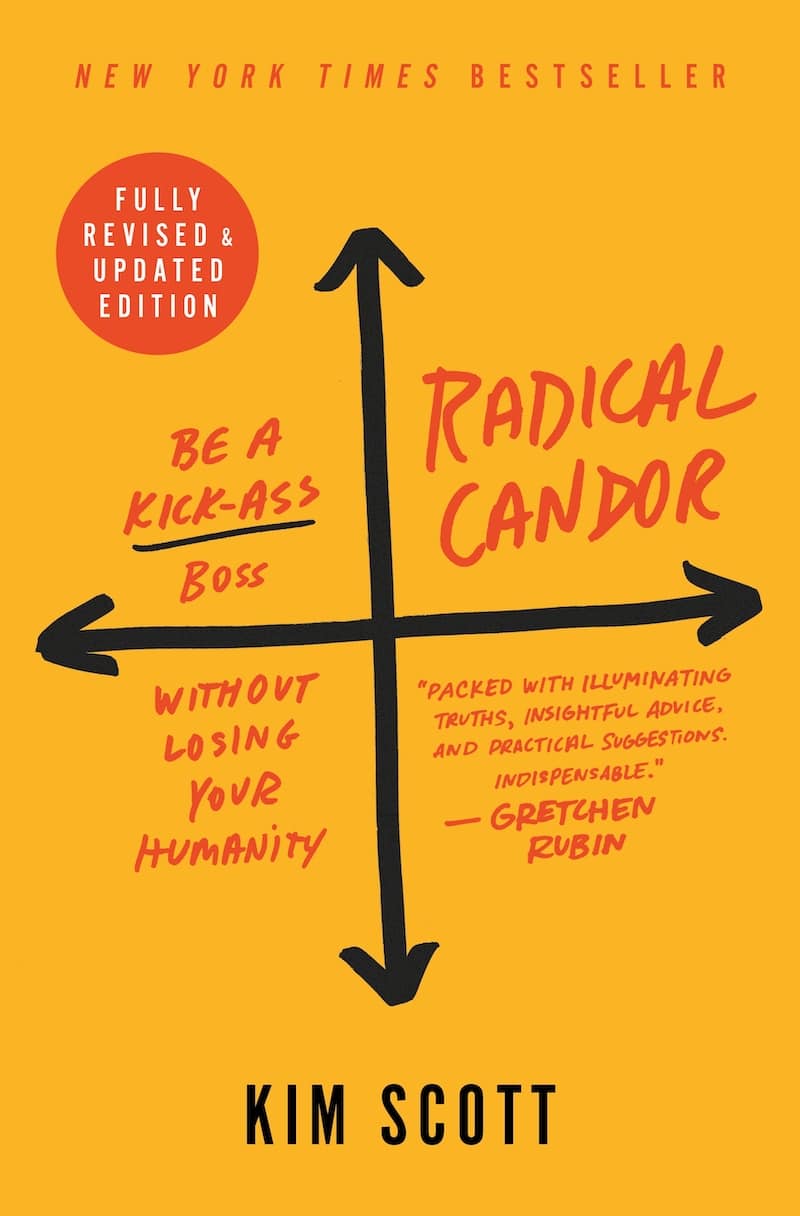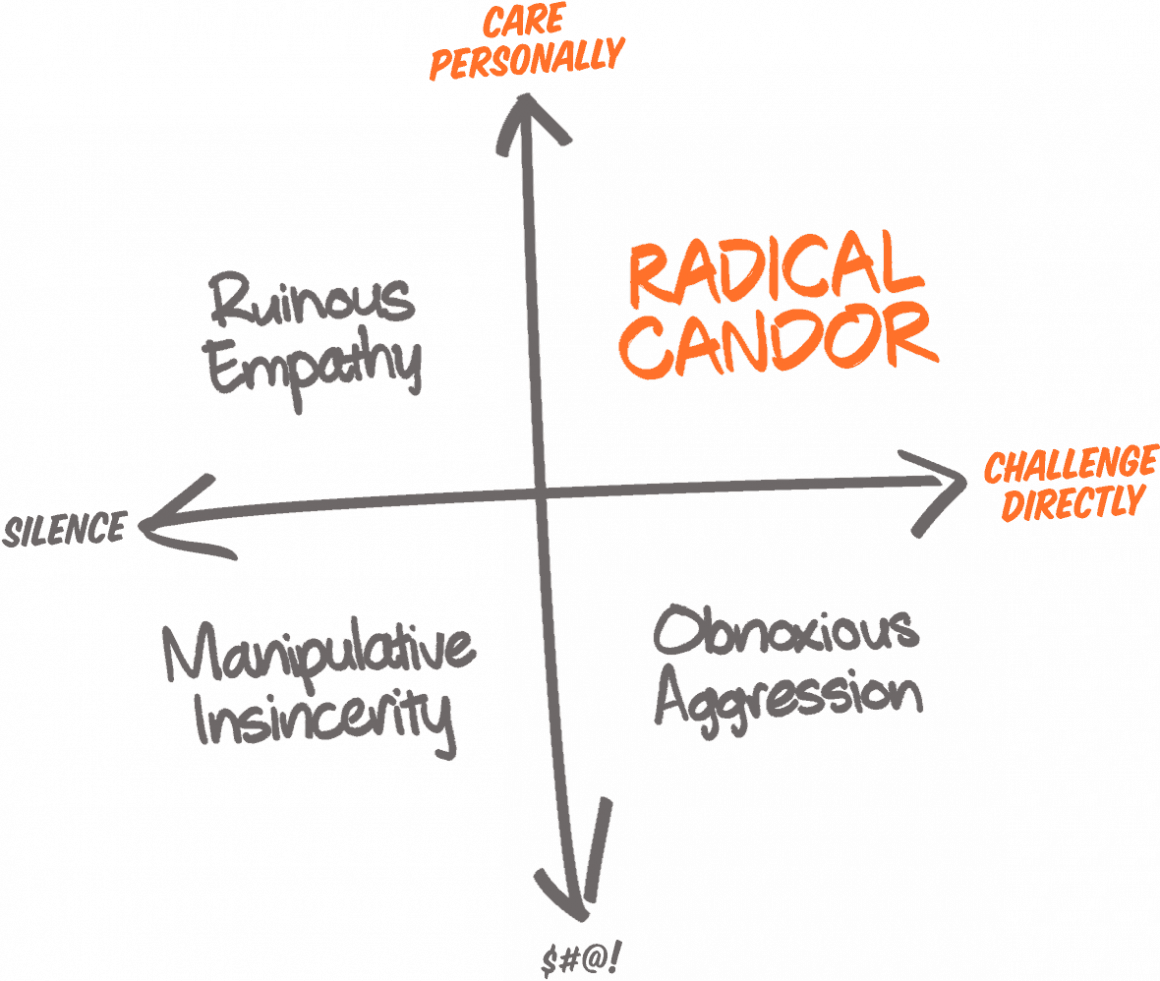Radical Candor is a great book for managers (the preferred term used in the book is ‘boss’). It underscores the importance of having good relationships with your team and lays down the steps you can follow to do this. The books first defines what the job of a manager is and how can they use the radical candor guidance technique to do it well. In this two part post, am going to try and summarise the key lessons from this extremely actionable book.

What is a manager’s job?
“Management” is a job, not something that is done over and top of other responsibilities. What we consider emotional babysitting is the real job of a manager. Connecting with people, establishing trust and then giving them the right guidance is what being a good boss is all about. This books lists out three key jobs of a manager.
- Guidance -> giving feedback to people
- Team -> building and maintaining the right team
- Results -> driving results collaboratively
In one sentence, guiding your team to drive results collaboratively is the core job of a manager. I will try and summarise the key lessons from this book that help a manager achieve these three objectives. In this part, I look at how to provide guidance and in the second part of this post, I look at how to create a team and drive them to results collaboratively.
Guidance
Radical Candor is a guidance philosophy. Scott defines two parameters on which relationships operate in a work setting. These are challenging directly and caring personally. Caring personally is caring not only how a person performs in office but more holistically about their well being. When people feel they are cared for and can be themselves at work, they bring their whole selves to work (I highly recommend watching Mike Robbins talk about this). When you challenge people directly, you offer clear and actionable feedback without any ambiguity. This is hard for us to do as we are trained to avoid conflict and confrontation.

Radical candor lies at the intersection of Caring Personally and Challenging Directly. When you challenge people, who know you care about them and trust you, something great happens. People are more likely to appreciate guidance and you are more likely to give it out with ease and sans apprehension.
The other three quadrants are not good places to be in. Obnoxious aggression is when you challenge people directly but you are considered rude because you don’t have the trust necessary for the other person to feel that your heart is in the right place. You need to move up on the caring personally axis. This you can do by spending time getting to know them and what makes them tick (we will discuss this in the Team section in the next post). Ruinous empathy is when you offer care but do not challenge people enough by giving them clear feedback. As the name suggest, this ruins their growth prospects as they continue to make the same mistakes. Finally, the worst quadrant is the manipulative insincerity. This is when managers don’t care about their people’s growth at all. They don’t care about the person as a human being and are not vested in their growth enough to challenge them or to guide them. It is worth mentioning that these quadrants apply to relationships outside work too. This framework can work between a husband and wife, siblings, friends, teachers and students, etc. You can always move between quadrants by either striving to care more personally or by offering more direct challenges.
It is clear that managers must strive to be in the radical candor quadrant while giving feedback. The right way to give feedback is to first set up the right amount of trust and then to speak clearly in unambiguous terms. There is a great story in the book about how even complete strangers can give radically candid guidance. The author and her dog were standing near a busy road and her dog was constantly pulling the leash. A passerby observed them and said something like ‘I see you love your dog but the way you’re letting it pull on the leash, you will get her killed’. This is a great example of radical candor. By starting the conversation with ‘it seems you love your dog’, he established trust and clarified that he wasn’t coming from a place of judgement. By saying ‘letting it pull its leash.. you’ll get it killed’, he gave clear feedback on what she needed to change and what the effect of not changing would be. The man then looked at the dog and with a stern voice said ‘sit’. The dog did. It was not rude, it was clear.
Tactics for radical candor guidance
- Be humble while giving feedback. Use the situation-behavior-impact framework to give specific feedback. Understand the situation and talk through the behaviour you saw while explaining the impact the behavior had on the situation. Clarifying things in this way allows you to explain your position easily and lets the person appreciate how their behaviour played out.
- Lead by example by asking your team to give you feedback. Asking your team to criticise you or give you feedback and then accepting it graciously is a great for them to learn how to ask or take feedback.
- Praise in public and criticise in private. This one is quite common and it is generally a good idea to criticise in private. There are always exceptions to this rule and in some cases you may even not want to praise in public (for fear of not having enough context and accidentally praising one person when in fact a whole team was responsible for something). If you have a good relationship with your team, you can criticise in public as well to use the moment to coach the larger group but use this sparingly and carefully.
- Guide people in the moment and immediately. Managers delay feedback and review meetings by kicking it ahead. They dread the long and hard conversations and when the time comes, they try to address multiple issues in one go. This doesn’t go down well at all. Giving instant feedback is like brushing your teeth and not a root canal that you dread it to be. Short 3-4 minute walks or sidebar discussions can be had to quickly offer quick guidance. Use the situation-behavior-impact framework to do these quick discussions.
- Don’t personalise. “I think that’s wrong”, not “You’re wrong”. The phrase ‘don’t take it personally”, is just the worst thing you can do.
- Don’t fall for gender politics and start pulling your punches. If you really care for your female colleagues, you will challenge them directly just as you would a man. This has an opposite side too. As a woman, don’t fall for the competency-likability trap. It is common for managers to give feedback like ‘you’re coming out too aggressive’ to women, but it is your job as a woman, to stay your ground and question if the behaviour you exhibited, would get a man labelled the same way. Your job is not to become more likeable. It is your manager’s job to fight the gender bias in your team.
In the next part of this post, I look at the two remaining jobs of a manager, which are building and maintaining a team and driving the team to results.
I run a startup called Harmonize. We are hiring and if you’re looking for an exciting startup journey, please write to jobs@harmonizehq.com. Apart from this blog, I tweet about startup life and practical wisdom in books.